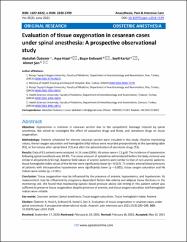| dc.contributor.author | Özdemir, Abdullah | |
| dc.contributor.author | Hızal, Ayşe | |
| dc.contributor.author | Erdivanlı, Başar | |
| dc.contributor.author | Kartal, Seyfi | |
| dc.contributor.author | Şen, Ahmet | |
| dc.date.accessioned | 2022-10-04T12:48:51Z | |
| dc.date.available | 2022-10-04T12:48:51Z | |
| dc.date.issued | 2021 | en_US |
| dc.identifier.citation | Ozdemir, A., Hizal, A., Erdivanli, B., Kartal, S. & Sen, A. (2021). Evaluation of tissue oxygenation in cesarean cases under spinal anesthesia: A prospective observational study. Anaestesia Pain & Intensive Care, 25(3), 280-286. doi.org/10.35975/apic.v25i3.1525 | en_US |
| dc.identifier.issn | 1607-8322 | |
| dc.identifier.issn | 2220-5799 | |
| dc.identifier.uri | doi.org/10.35975/apic.v25i3.1525 | |
| dc.identifier.uri | https://hdl.handle.net/11436/6646 | |
| dc.description.abstract | Objective: Hypotension is common in cesarean section due to the sympathetic blockage induced by spinal anesthesia. We aimed to investigate the effect of vasoactive drugs and fluids, and uterotonic drugs on tissue oxygenation.
Methodology: Patients scheduled for elective cesarean section were included in this study. Routine monitoring values, thenar oxygen saturation and hemoglobin (Hb) indices were recorded preoperatively at the operating table (T1), at 3rd minute after spinal block (T2) and after the administration of uterotonic drugs (T3).
Results: Data of 61 patients were analyzed. In 24 cases (39%), Hb values were < 11 g/dl. The incidence of hypotension following spinal anesthesia was 34.4%. The mean amount of ephedrine administered before the baby removal was similar in all patients (214 mg). Baseline StO2 values of anemic patients were similar to that of non-anemic patients; tissue hemoglobin index values of the former were significantly lower (p = 0.017). T3 systolic arterial blood pressures of patients with intraoperative hypotension were significantly lower (p = 0.001); tissue oxygen saturation and Hb indices were similar (p = 0.301).
Conclusion: Tissue oxygenation may be influenced by the presence of anemia, hypovolemia, and hypotension. Its measurement may be influenced by pregnancy-dependent factors like edema and adipose tissue thickness in the monitoring site. We found that maintaining systolic blood pressure above 100 mmHg in this patient cohort was sufficient to preserve tissue oxygenation despite presence of anemia; and tissue oxygen saturation and hemoglobin indices were reliable. | en_US |
| dc.language.iso | eng | en_US |
| dc.rights | info:eu-repo/semantics/openAccess | en_US |
| dc.subject | Cesarean section | en_US |
| dc.subject | Spinal anesthesia | en_US |
| dc.subject | Tissue oxygen saturation | en_US |
| dc.subject | Tissue hemoglobin index | en_US |
| dc.subject | Anemia | en_US |
| dc.title | Evaluation of tissue oxygenation in cesarean cases under spinal anesthesia: A prospective observational study | en_US |
| dc.type | article | en_US |
| dc.contributor.department | RTEÜ, Tıp Fakültesi, Cerrahi Tıp Bilimleri Bölümü | en_US |
| dc.contributor.institutionauthor | Özdemir, Abdullah | |
| dc.contributor.institutionauthor | Erdivanlı, Başar | |
| dc.identifier.doi | 10.35975/apic.v25i3.1525 | en_US |
| dc.identifier.volume | 25 | en_US |
| dc.identifier.issue | 3 | en_US |
| dc.identifier.startpage | 280 | en_US |
| dc.identifier.endpage | 286 | en_US |
| dc.relation.journal | Anaestesia Pain & Intensive Care | en_US |
| dc.relation.publicationcategory | Makale - Uluslararası Hakemli Dergi - Kurum Öğretim Elemanı | en_US |


















